Annual Percent Change
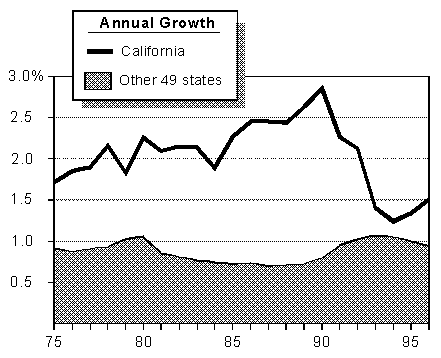
- California's population has consistently grown faster than the population of the other 49 states. For much of the 1970s and 1980s, California grew at roughly twice the rate of the rest of the nation, peaking at more than three times the other states' growth rate in 1990.
- The recession markedly slowed California's population growth rate, bringing it down close to the national level. Recently, the state's population growth rate began to turn up again in response to California's economic recovery, but it is still well below its pre-recession levels.
1995

- Two-thirds of the population lives in the eight counties with populations greater than one million. Five of those eight counties are in Southern California.
- Almost 30 percent of all Californians live in Los Angeles County.
- A total of 5.5 million people -- one in six -- live in the counties of the Central Valley and the Sierra foothills.
Population Growth Rates for California Counties 1994 to 1995
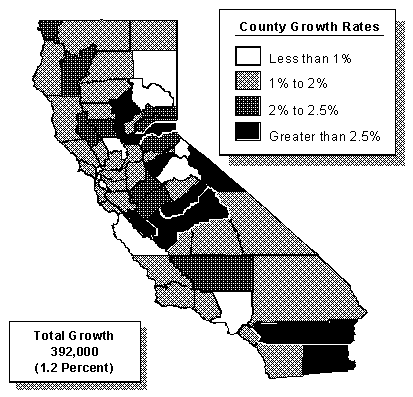
- The highest population growth rates are occurring mainly in the Central Valley and foothill counties, and in Riverside and Imperial Counties in Southern California. About 4.1 million Californians live in those counties that are growing by 2 percent or more annually.
- Annual growth is less than 2 percent in the urban coastal counties and only 0.3 percent in Los Angeles County.
- Slow growth in Los Angeles County resulted in an overall statewide growth rate of 1.2 percent -- versus a growth rate of 1.6 percent for the other 57 counties.
Annual Population Increase (In Thousands)
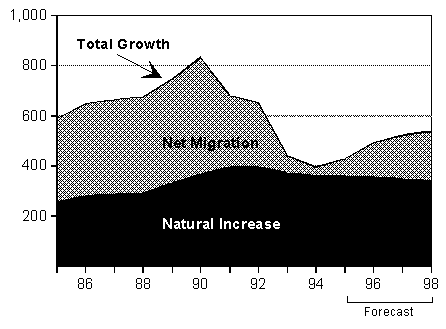
- During the recession, growth from net migration almost stopped. There was a net outflow of people from California to other states in response to job losses, although continued foreign immigration offset this loss.
- Resumed job growth now is resulting in a net population inflow from other states, although this gain is well below the levels of the late 1980s.
- California's population would continue to grow by more than 1 percent annually due to natural increase, even in the absence of gains from migration.
1995 Through 1998
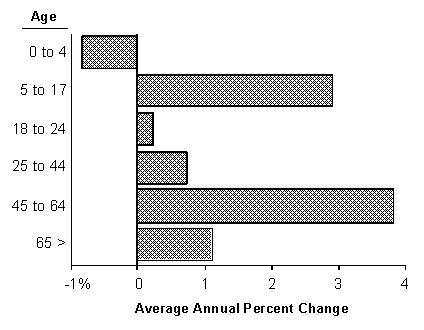
- The older portion of the working-age population (ages 45 to 64) is growing rapidly as the babyboomers enter this age group. However, the younger portion of the working-age population is growing much more slowly.
- The school-age population (ages 5 to 17) also is growing relatively rapidly, reflecting the rise in birth rates in the late 1980s. Recently, birthrates have moderated, which has resulted in a small decline in the number of preschool-age children (ages 0 to 4).
- After 1998, the young adult population will again resume rapid growth, causing increased pressure on the state's higher education systems. Courts, jails and prisons also could face increased pressure.
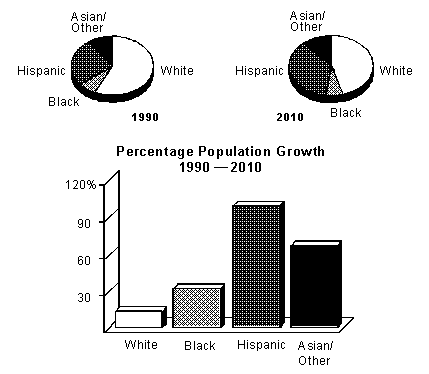
- Between 1990 and 2010, California's Hispanic population will double, and the state's Asian population will grow by two-thirds.
- By 2010:
- More than half of California's population will be Hispanic, Asian, or Black.
- More than two-thirds of school-age children will be Hispanic, Asian, or Black.
- The population over age 50, however, will remain predominantly (non-Hispanic) White.
 Table
of Contents
Table
of Contents  Part
I, California's Economy
Part
I, California's Economy  Part
III, State and Local Finance
Part
III, State and Local Finance
Return to LAO Home Page







